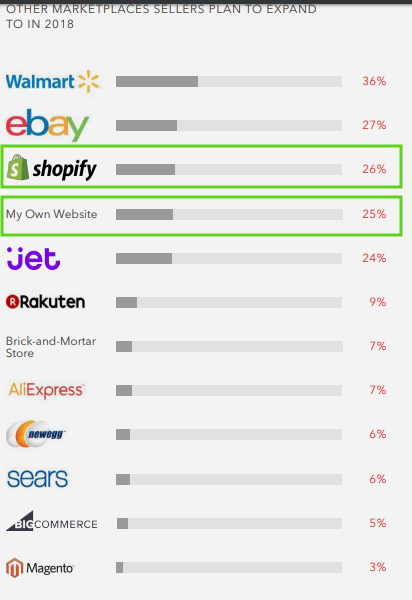

Want to Sell Amazon products on Shopify? Here is what you need to do?

Running short of time? Get PDF of the blog in your mail.
|
Play Now

|
There are more than 5 million sellers on Amazon and among them 140,000 earned revenue in excess of $100,000 in year 2017 reports Recode. This year 1,029,528 new sellers joined Amazon which is equivalent to 2,975 new sellers every day.
All of the aforementioned information paints a rosy picture inclined toward Amazon and it is indeed a popular destination for sellers. However, going all-in on Amazon is also not a great idea. Any operational hazards can choke your earnings.
Thankfully, Sellers are already aware and are diversifying their channels to add more sales streams. In this regard the study conducted by Feedvisor offers insights:
The sellers surveyed by Feedvisor wanted to offer their products on marketplaces as well and among them Walmart is the first choice followed by eBay. Other marketplaces where they wanted to list their products were Jet, Rakuten, Aliexpress, Newegg, and Sears.
It is understandable as well. The sellers don’t want to limit their options, therefore, other marketplaces become a natural choice for them.
However, it is 3rd and 4th options, namely, Shopify and Own websites followed by Bigcommerce and Magento is an interesting phenomenon.
It indicated a popular trend among the 3rd partly sellers. First, they use marketplaces to test their products and once they’re convinced with the potential of their products they want to build their brand independent of other brand’s identities.
Here are other reasons for sellers as well to sell Amazon products on their website.
-
- They can build their brand.
- They can build their loyal customer base as they don’t get customer’s details from Amazon. It gives them the flexibility to expand beyond Amazon.
- Merchants can leverage their website for B2B sales too.
- Merchants can personalize their listings such as use video to educate their clients which is not possible at Amazon.
Not only that sellers face some malpractices by their competitors which sometimes results in Amazon banning their products which are beyond their control. Some of the most common malpractices used by other sellers against your products can be:
1. The competitor buys a large portion of some particulars items in large numbers, making the product out of stock for that particular item and then return the items later which causes double damage. First is you’re out of BuyBox for the item and second is your account can be suspended.
2. A lot of new sellers avoid registering their brands which needs a trademark, competitors sellers can change the images of your items. They can put the wrong image in front of another product which can result in a customer complaining against your products.
3. Leaving negative feedback on your listing is the most common strategy by the competitors to impart a bad name for your business. Also, what they can do is order your items multiple times and then return it, so that you miss the Amazon’s criterion of minimum Order Defect, Negative Feedback, and return rate.
However, Amazon is taking all the care to avoid all these malpractices like employing bots to look out for fake reviews since they mostly use the same set of keywords and don’t share their experience.
However, opening your own websites saves you from getting your account suspended for the reasons beyond your control and you own your destiny.
Wanting to sell Amazon products on Shopify? Use Amazon Importer by CedCommerce
Amazon importer termed as multichannel Importer offers the easiest way to migrate your products from the Amazon Marketplace to your Shopify store. It enables Amazon sellers to import all of the item details – Images, Inventory, Price – from their Amazon seller center to Shopify in one click.
How does it work?
The app works as a bridge between your Shopify store and Amazon seller account through the establishment of an API-based communication channel that facilitates the product transfer. First, all of the products are imported into the app and then are transferred to your Shopify Store.
Key Utilities of the Amazon Importer:
Bulk Item Transfer:
The function empowers merchants to select all the products at once and import them to their Shopify Stores.
Variations-Compatible:
The app also fetches the variations of the main products, therefore, reducing the complexity involved with product transfer.
High-Resolution Image Transfer:
Merchants can also fetch the main image from their Amazon Seller account to their Shopify store.
Flag Products:
The app provides the flexibility of flagging (omitting) items in which merchants don’t want to be part of their brand at their respective Shopify store.
Daily Autonomous Sync:
The app updates any inventory or pricing related changes made to Amazon Listings at the merchant’s Shopify Store.
Conclusion:
The largest e-commerce sales season is just around the corner – Halloween, Thanksgiving, and Black Friday, Cyber Monday, and Small Business Saturday. Therefore, it’s a great idea to get started.



Joe
I would love to list my Merch By Amazon products on my Shopify storefront for more visibility. Is there a method for this?
Norman Patterson
I want to sell Amazon products on my shopifly website,Thank you Norm
Amaan Irfan
Hello norman,
If you want to sell your Amazon products on your Shopify store, you need to have a seller account on Amazon with at least few products listed on it. Else, you require amazon affiliate keys if you want to dropship the products from amazon.
To get more information or assistance contact deeptishukla@cedcommerce.com